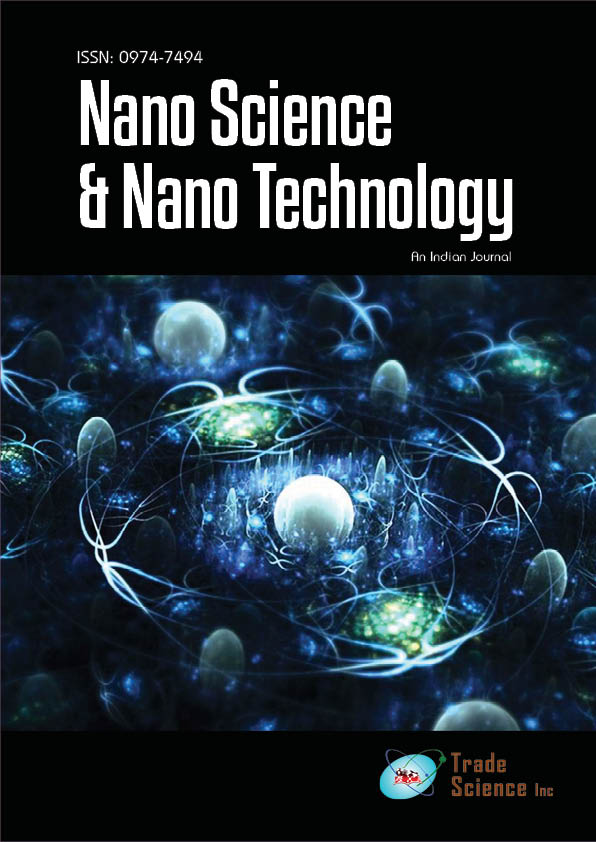Current opinion
, Volume: 16( 4) DOI: 10.37532/ 0974-7419.2022.16(4).156Nano biotechnology in healthcare
Citation:Varsha Rai. Nano biotechnology in healthcare . Nano Tech Nano Sci Ind J. 2022; 16(4):156 ©2022
Abstract
Utilizing matter at the atomic, molecular, and supramolecular levels for industrial purposes is known as nanotechnology. Early definitions of nanotechnology, now known as molecular nanotechnology, focused on the specific technological objective of accurately manipulating atoms and molecules for the creation of macroscale objects
What is Nanotechnology?
Utilizing matter at the atomic, molecular, and supramolecular levels for industrial purposes is known as nanotechnology. Early definitions of nanotechnology, now known as molecular nanotechnology, focused on the specific technological objective of accurately manipulating atoms and molecules for the creation of macroscale objects.
Size-based definitions of nanotechnology encompass a variety of scientific disciplines, including surface science, organic chemistry, molecular biology, semiconductor physics, energy storage, engineering, microfabrication, and molecular engineering. The related research and applications include a wide range of topics, from modifications of traditional device physics to entirely novel strategies based on molecular self-assembly, from creating novel materials with nanoscale dimensions to precise control of matter at the atomic level.
The physical, chemical, and biological characteristics of matter, such as gases, liquids, and solids, can alter significantly from those of bulk materials and individual atoms or molecules at the nanoscale.
Compared to other shapes or sizes of the same material, some nanostructured materials are stronger or exhibit distinct magnetic characteristics. Others are more adept at transferring electricity or heat. As their size or structure is changed, they may become more chemically reactive, reflect light better, or change colour.
A nanometer, or 10-9 of a meter, is one billionth of a meter.
Nanotechnology in health
Health applications of nanotechnology include Nano biotechnology and bio nanotechnology, which combine concepts, methods, and disciplines from biology with nanotechnology.
While bio nanotechnology refers to the use of biological elements in nanotechnology, Nano biotechnology refers to the application of nanoscale objects for biotechnology.
Health care has already dramatically improved thanks to nanotechnology. Nanoparticles are being used by researchers in medication delivery systems, medical imaging, and tumours targeting. Some medicines based on nanoparticles have several uses; they can both detect cancers and transport drugs to treat them. Nanotechnology is also being used to offer scaffolding for tissue regeneration or wound treatment, as well as to reduce the cost and speed up DNA sequencing.
Traditional dose forms have some drawbacks, which nanotechnology helps to solve. This technique promises to be highly effective in both diagnosing and treating diseases. As a result, nanomedicine is becoming increasingly well-liked. However, because nanoparticles and nanotechnology as a whole are still a relatively new idea, there isn't any experimental evidence that they have any negative impacts. This knowledge gap could make it more difficult to regulate the safety of Nano therapeutics and pose special assessment problems for us.
Currently, cancer treatment and the development of smart tablets both involve nanomedicine.
Smart drugs
Smart pills are Nano-level electronic devices that resemble pharmaceutical tablets in shape and design but carry out more complicated tasks like sensing, imaging, and drug administration. Various types of smart pills, including dose-tracking pills and the PillCam, a capsule with a tiny video camera, have been developed in the past with the aid of nanotechnology.
Diagnosis and treatment of cance
The harm done to the body's healthy cells during chemotherapy and radiation treatments is a major issue with these treatments. In order to effectively transport medications and other therapeutic treatments to particular tumour areas and target cells with minimal hazardous side-effects, skin cancer is being treated using novel nanomedicine methods. Nano Flares is a brand-new technique being developed by nanomedicine to find cancer cells in the circulation. Nano Flares are small, light-emitting particles that are made to bind to specific genetic targets in cancer cells, aiding in the detection of these cells.
Nanobots
Nanobots are microscopic surgical robots that operate on a micron-scale. They are implantable and can be used to restore and swap out intracellular structures. By substituting DNA molecules, they can also multiply themselves to make up for genetic deficiencies or even end diseases. This building is still being built.
Currently, nanobots are being tested to operate on eyes using a small needle put into the retina. This needle can be guided by surgeons using a specific magnetic field
The function of nanotechnology in the delivery of targeted drugs
Target-specific drug delivery using Nano vectors has considerable promise for the treatment of many diseases. Targeted medication delivery is crucial, particularly when the hydrophobic drug's solvents are hazardous. These solvents may infiltrate the blood stream or other body fluids and contaminate them if they are released somewhere other than the target cell. Drugs can be continuously released under control in the desired quantity because to nanostructures. Medication doses are decreased via targeted and localised drug delivery. Because of their small size and ability to reach deep inside tumour cells, nanoparticles (NPs) have the potential to enhance cancer therapies.
A new era of nanomedicine and life nanoscience has been ushered in by nanotechnology, and this new period holds great promise for more effective treatment of life-threatening or crippling illnesses. Currently, nanomedicine is at the first generation (passive) stage of nanotechnology, but with the start of early clinical trials, particularly in the areas of controlled drug delivery and cell treatments, advancement has now crossed the threshold of the second generation (active nanomaterials). Wireless electro-chemotherapy and electro-stimulation technologies and devices have made significant advancements, but further research and development, as well as pre-clinical safety and efficacy studies, are still required.

